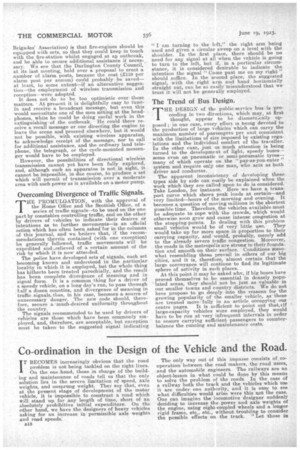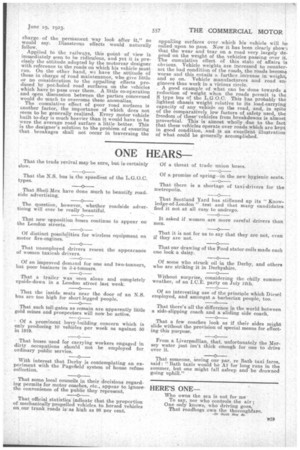Co-ordination in the Design of the Vehicle and the Road.
Page 2

Page 3

If you've noticed an error in this article please click here to report it so we can fix it.
IT BECOMES increasingly obvious that the road -problem is not being tackled on the right lines. On the one hand, those in charge of the building and maintenance of roads tell us that the only solution lies in the severe limitation of speed, axle weights, and unsprung weight. They say that, even at the present stage of development of the motor vehicle it is -impossible to construct a road which Will sand up for any length of time, short of an absolutely prohibitive initial expenditure. On the other hand, we have the designers of heavy vehicles asking for an increase in permissible axle weights and road speeds.
u18
The only way out of this impasse consists of cooperation between the road makers, the -road users, and the automobile engineers. The railways are an object-lesson in what could be done by this means to solve the problem of the roads. In the case of a railway both the track and the vehicles which use it are under one authority, and it is easy to see what difficulties would arise were this not the case. One can imagine the locomotive designer suddenly deciding to increase the power and axle weights of the engine, using eight-coupled wheels and a longer rigid frame, etc., etc., without troubling to consider the possible effects on the track. "Let those in charge of the permanent -way look after dt," ne would say. Disastrous effects mould naturally follow.
Applied to the railways, this point of view is immediately seen to be ridiculous, and yet it is precisely the attitude adopted by the motorcar designer with reference to the roads on which his vehicle must run. On the other hand, we have the attitude of those in charge of road maintenance, who give little or no consideration to the appalling effects produced by pot-holed road surfaces on the vehicles , which have to pass over them. A little co-operation and open discussion between the parties concerned would do much to overcome these anomalies.
The cumulative effect of poor road surfaces is another factor, the importance of which does not seem to be generally realized. Every motor vehicle built to-day is much heavier than it would have to be were the average road surface a littlebetter. This is the designer's solution to the problem of ensuring that breakages shall not occur in traversing the appalling surfaces over which his vehicle will be called upon to pass. Now it has been clearly show2 that the wear and tear on a road very largely depend on the weight of the vehicles passing over it. The cumulative effect of this state of affairs is obvious. Vehicle weights, are increased to counteract the the bad condition of the roads, the roads become worse and this entails a further increase in weightl, and so on. Vehicle manufacturers and road en}.
gineeri thus work in a vicious circle. • , A good example of what can be done towards reduction of weight when the roads permit is th S type bus of the L.G.O.C. This has probably th lightest chassis weight relative to its load-carrying capacity of any vehicle on the road, and,in spite of the comparatively low factors of safety used, th freedom of these* vehicles from breakdowns is almos proverbial. This is almost wholly due to the fac that these vehicles operate over roads which are kep in good condition, and is. an excellent illustration of what could be generally accomplished.




























